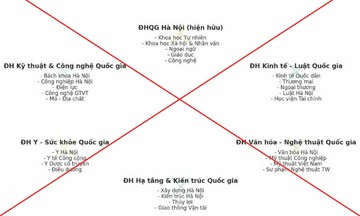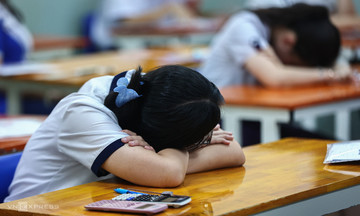The female student said she initially planned to apply to two economics universities in Hanoi. She submitted her IELTS 7.0 certificate for combined consideration with her high school graduation exam score. However, achieving only 22.5 in the D01 combination (Math, Literature, English), a score below her expectations, Thanh had to recalculate her application strategy. She applied for IELTS conversion at more universities and also used her academic transcripts for admission consideration.
Submitting over 20 applications to six universities, Thanh calculated her admission scores, after adding priority points and bonus points, to be between 25 and 27.9, depending on the university.
"I never thought my admission score would exceed my exam score by so much, in some cases by more than 5.5 points," Thanh said.
Viet Quoc, from Ninh Binh, was worried he wouldn't be admitted to International Relations or English Language programs at mid-range or higher public universities due to his high school graduation exam score of just over 20. However, with a three-year GPA of 24.92 and an IELTS score of 6.5, Quoc was admitted to his desired program with an admission score of 26.25, 0.15 higher than the standard admission score.
This situation is quite common in this year's admissions season, according to some admissions experts. Mr. Khang, a leader at a northern university, recounted the case of a candidate who scored 23 on the graduation exam but was admitted to University A with an admission score of 27. However, this student was not admitted to University B, even though the standard admission score was only 24.
"With this year's calculation method, the standard admission scores at some universities have been distorted and no longer simply reflect the candidates' actual exam scores," Mr. Khang said.
He pointed out three reasons for this situation. First, the policies for awarding bonus points to candidates vary between universities, leading to different admission scores and standard admission scores.
For example, many universities only convert, but do not add bonus points, for candidates with international certificates when considering them in combination with high school graduation exam scores. Others, however, add a maximum of 3/30 points.
At the University of Commerce, a student with an IELTS score of 6.0 will have it converted to 10 points for English, and then receive an additional two bonus points.
The University of Foreign Languages, Hue University, follows a similar practice. Two of its programs have a standard admission score of 30/30, even though no student nationwide achieved a perfect score on the Math, Literature, and Foreign Language combination.
 |
High school graduation exam candidates in 2025. Photo: Thanh Tung |
High school graduation exam candidates in 2025. Photo: Thanh Tung
The second reason Mr. Khang cited is the large discrepancy in how international certificate scores are converted between universities.
For example, among the top economics universities, for an IELTS score of 5.5, the Foreign Trade University does not convert it; the National Economics University converts it to 8 points for English, the Banking Academy to 8.5, the Academy of Finance to 9, and the University of Commerce to 10.
IELTS conversion table for over 70 universities
Another reason is that when developing the conversion formula, many universities calculate it to prioritize their preferred admission methods, such as academic transcripts, competency assessment tests, or application portfolios.
"This pushes up the standard admission score based on the high school graduation exam results," he said. "When looking at the standard admission scores announced by universities, many people think they need 27 points on the graduation exam to be admitted to program X at university Y. But the number of candidates who actually achieve this exam score might only be a few dozen, or even just a few."
Mr. Bui Van Cong, a competency assessment test tutor in Ho Chi Minh City, and Mr. Dat, Head of the Training Department at a southern university, agree.
Mr. Cong believes that the score conversion between methods makes the results more unpredictable for both universities and candidates.
"The difficulty of the graduation exam itself is not consistent across subjects, leading to significant differences in admission scores between combinations. Furthermore, each university has its own conversion formula with varying discrepancies," Mr. Cong said.
Elaborating further, Mr. Dat explained that the Ministry's aim in requiring equivalent score conversion between methods is to ensure fairness among the admission methods. However, in reality, there are a myriad of conversion formulas, with each university having its own method. If a university wants to prioritize a certain method, it can still set a conversion function with coefficients that favor that method.
Moreover, competency assessment and GPA scores are higher this year than in previous years. When factored into the conversion formula, the standard admission score for the high school graduation exam method is also pushed higher.
He gave the example of University X, which stipulates that a GPA of 24 is equivalent to a graduation exam score of 20 and a competency assessment score of 650. During the virtual filtering process, if the university sets the standard graduation exam score at 20, and the number of students admitted based on GPA and competency assessment exceeds the quota, the university is forced to raise the admission threshold to 21-22. Thus, the standard admission score based on the graduation exam increases, but in reality, the number of students admitted through this method is not high.
According to Mr. Dat, the situation of low exam scores but high admission scores is also due to the expansion of admission combinations. Many universities only specify one or two main subjects, allowing candidates to choose the subjects with their best scores. Compared to previous years, where there were only four mandatory combinations for each program, the number of combinations has doubled or tripled, and the flexibility in subject selection leads to better admission scores.
These realities also explain the decrease in standard admission scores for Medicine and Pharmacy, as most universities in these fields only consider high school graduation exam results, using a few limited combinations, mainly B00 (Math, Chemistry, Biology).
An admissions expert suggested that the Ministry could mitigate this situation from next year by tightening the awarding of bonus points, similar to the awarding of priority points for regions and demographics.
"For the past three years, the Ministry has tightened the awarding of priority points so that candidates with higher exam scores receive fewer priority points, to ensure fairness," he said. "Now, the maximum bonus point of 3/30 seems like a tightening, but in reality, it has led to a proliferation."
He believes that 3/30 is too much. The Ministry could require universities to tighten their criteria and bonus point levels so that admission scores and standard admission scores are more realistic and closer to candidates' actual exam scores.
Duong Tam - Le Nguyen
*Some candidate and expert names have been changed.












